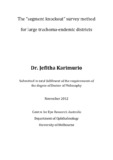| dc.description.abstract | Prevalence surveys are mandatory before new trachoma control projects are funded and existing ones continued. When a large administrative district with >200,000 people is
surveyed as one trachoma intervention unit, the survey clusters are widely spaced and it is difficult to establish the distribution of the disease at the sub-district level with certainty. As a result, some trachoma-endemic areas in Kenya have been missed out and non-endemic areas included in mass antibiotic treatment. The other challenge is the large sample size required in standard trachomatous trichiasis (TT) surveys that include participants aged >15 years. The main objective of this study was to develop an effective and efficient survey method to justify administration of mass antibiotic treatment for active trachoma. The other objective was to establish the optimum lower age limit of TT survey participants, to ensure that the time required to complete a TT survey was the same as the time required to complete a TF survey, while ensuring that the sample was adequately representative of the TT backlog. The costs of surveys and administration of mass antibiotic treatment were determined for comparison of the standard and new survey methods. Data sets for previous surveys were re-analysed to calculate the optimum lower age limit of TT survey participants and correction factors to extrapolate the total backlog of TT. A “Trachoma Survey by Segment” (TSS) method was developed to justify and reduce the cost of mass antibiotic treatment. It was tested in Turkana, a large hyper-endemic district with 543,199 people and Narok, a eso-endemic district with 576,388 people. Each district was divided into five geographical areas (segments). A segment had a population of 100,000–
200,000 people. Areas with similar risk of trachoma were aggregated in the same segment.
The segments with <10% prevalence of TF in children 1-9 years were excluded (knocked In Narok district 3,998 children aged 1-9 years were examined and the prevalence of TF was 11.0% (95%CI: 8.0%-14.0%). The entire district had received three rounds of mass antibiotic
treatment prior to this study. If this study was conducted by administrative district method, the whole population could have been treated for another three years. The TSS method identified three non-endemic segments which were excluded (knocked-out) from further treatment.
In Turkana district 2,962 people >40 years were examined and 7.8% (95%CI: 6.8%-8.8%) had TT while in Narok 2,996 people >40 years were examined and 2.9% (95%CI: 2.2%-3.6%) had TT. All the segments in both districts needed TT surgical services. The cost of a survey by the administrative district method was $15,726 to $28,905, while by the TSS method it was $31,917 to $40,610 ($6,383 to $8,122 per segment). In 2009, the unit cost of administration of mass treatment was $0.20 to $0.42 per person treated. In Turkana district (hyper-endemic setting), the total cost of a survey and administration of mass treatment by the TSS method was $11,705 (1.7%) more expensive that by the administrative district method. In Narok district (meso-endemic setting with clustered trachoma) the survey by TSS method and administration of mass treatment was cheaper by $168,275 (53.2%). It was concluded that the TSS is an effective trachoma survey method to identify the areas that need mass antibiotic treatment. For short term (<3 years) mass treatment in a hyperendemic
district like Turkana, the TSS method has no advantage over the administrative
district method. For long term treatment, the TSS method is recommended because some
segments may not require treatment for >3 years. The TT40 is an efficient trachoma survey method to determine the backlog of people with TT. | en |

